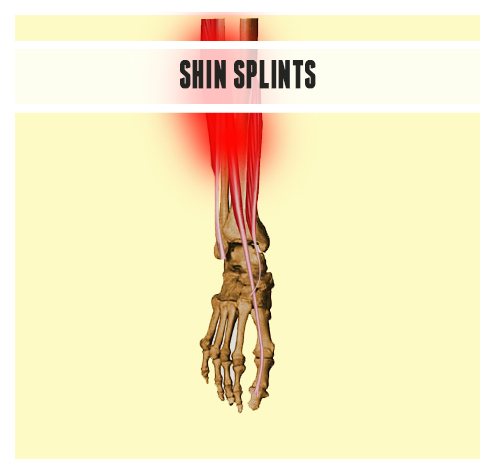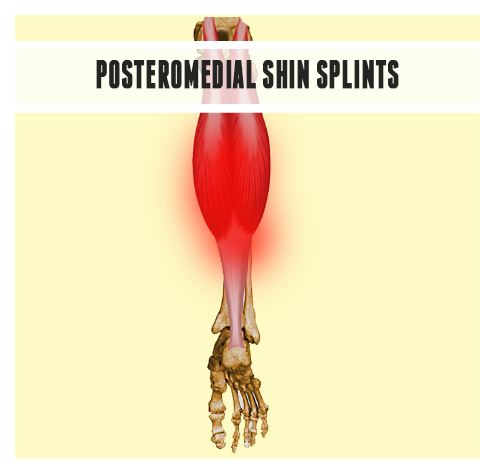Anterolateral Shin Splint, Posteromedial Shin Splint
A shin splint is a painful condition that occurs from damage to muscles along the shin, and the pain can occur anywhere from just below the knee to above the ankle.
The typical cause is continued, repeated stress to the lower leg, and is common in runners.
Shin splints may be caused by:
- An inexperienced runner just beginning to run (too much too fast).
- Running on side slopes (ie. banked tracks).
- Tight Calf Muscles, exerting extra force on shin muscles.
- A sudden change from soft to hard running surfaces.
- Poor or worn out anklewear.
- Excessive uphill running.
- Poor running mechanics. This could include:
- heavy forward lean
- excessive weight on the ball of the ankle
- running with toes pointed outward
- landing too far back on the heels causing the ankle to flap down
- overpronation
Of all of the possible causes, pronation (ankle roll) is the most likely to be overlooked.
Anterolateral Shin Splints
Anterolateral shin splints affect muscles in the front and outside parts of the shin, and is the result of a natural imbalance in the size of opposing muscles.
Shin muscles pull the ankle up, whereas the large and powerful calf muscle pulls the ankle down every time the heel strikes the ground when running. These calf muscles can exert a lot of force, enough force that can actually injure the shin muscles.
Anterolateral shin splints will cause pain in the front and outside of the shin. Initial pain is felt when the heel strikes the ground though eventually the pain just stays constant.
To allow this type of shin splint to heal, the person must stop running and do other kinds of exercise recommended by their doctor or physical therapist. Such exercises usually involve stretching the calf muscle, as tight calf muscles put a lot of pressure on the shin muscle and tendons.
A constant regimen of Blood Flow Stimulation Therapy™ (BFST®) is commonly recommended to improve the nutritious blood flow to the affected muscles and tendons, allowing them to heal more quickly and reduce pain in the area. Treatment of the calf muscle with Blood Flow Stimulation Therapy™ will also help increase the flexibility of this muscle, thus indirectly reducing the average level of strain on the shin muscle and tendon group.
Posteromedial shin splints
Posteromedial shin splints affect muscles in the back and inner part of the lower leg. These muscle groups are responsible for lifting the heel to support the runners weight on the ball portion of the ankle when running.
This type of shin splint is often caused by running on a banked track or non-level running surface or wearing improper shoes that do not protect the ankle from rolling (pronation).
Pain begins on the inside of the lower leg (usually within 7 inches above the ankles), but will worsen and continue to rise up the leg. Initially, only tendons of the muscles will become inflamed, but if running continues, the muscles themselves could become affected.
At the worst, the tendon could become detached from the bone – a painful occurrence that causes bleeding and excessive inflammation.
To allow a posteromedial shin splint to heal, the running must temporarily stop running and do other kinds of exercise recommended by their doctor or physical therapist. Special shoes may be prescribed during the healing phase, and it may be advisable to look into potential problems with pronation of the ankles. This can often be solved by researching and using shoes that better prevent pronation and/or the avoidance of running on side slopes.
Treating Tendon Injuries
It is important to treat tendon injuries as soon as possible, as any activity or strain you put on your tendon can re-injure it further.
The trick with any tendon injury is getting it toheal with minimal scar tissue formation. Even with optimum healing, there is always less elasticity in a previously injured tendon. This can cause the tendon to hurt during exercise and most everyday activities. However, if you heal your injured tendon efficiently and quickly, yourchance of re-injury later on is much lower.
Although it is recommended that you rest your injured tendons following injury it can be difficult to do if it is essential to use for daily activities. Fortunately, there are healing tool that can help treat your tendon and speed up the healing process so you can get back to a life without pain and risk of further injury.
Cold compression therapy and BFST® will reduce pain, swelling and tissue damage, and promote blood flow to heal your tendon and attached muscle faster and more completely than any other methods available.

